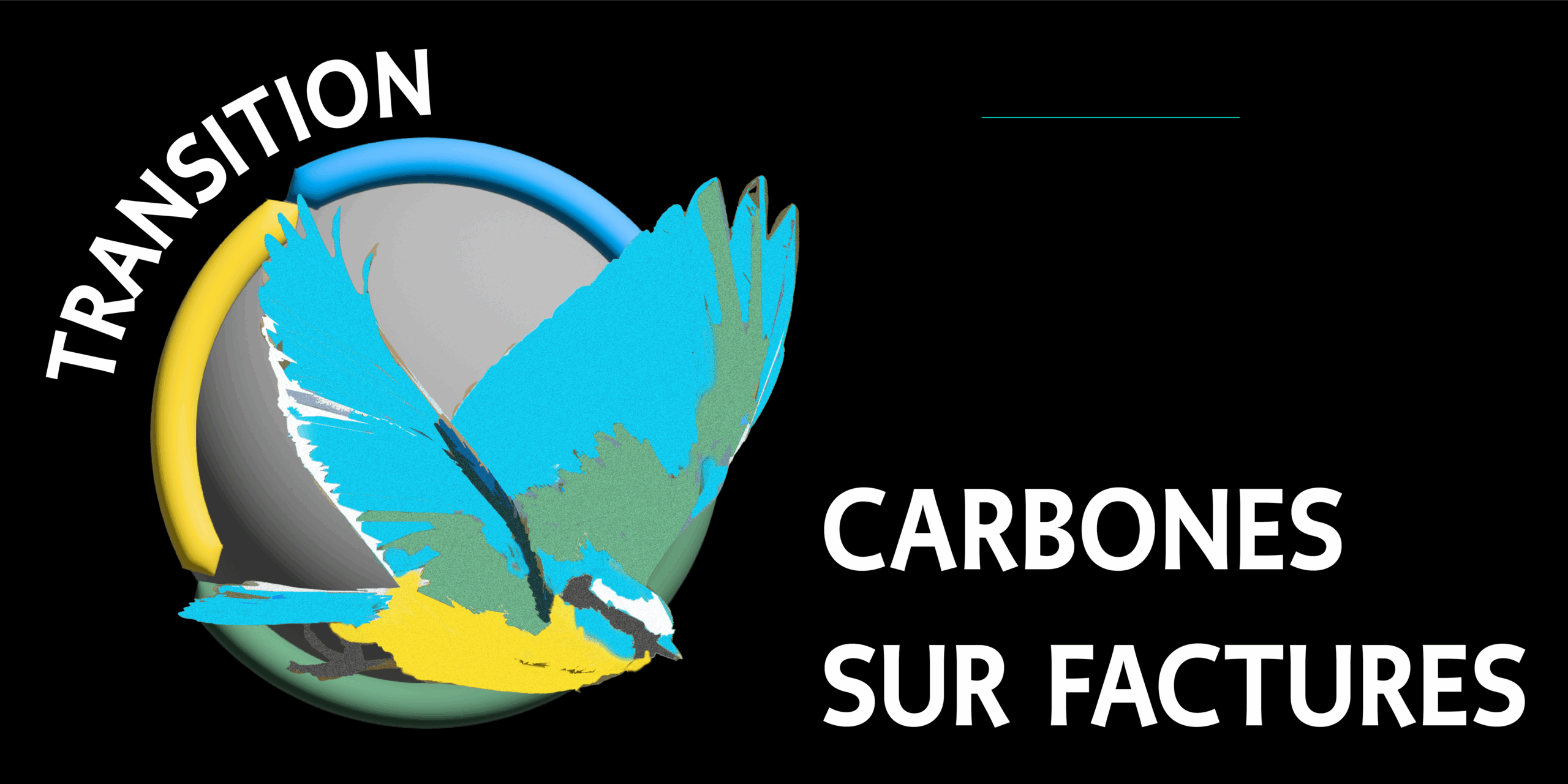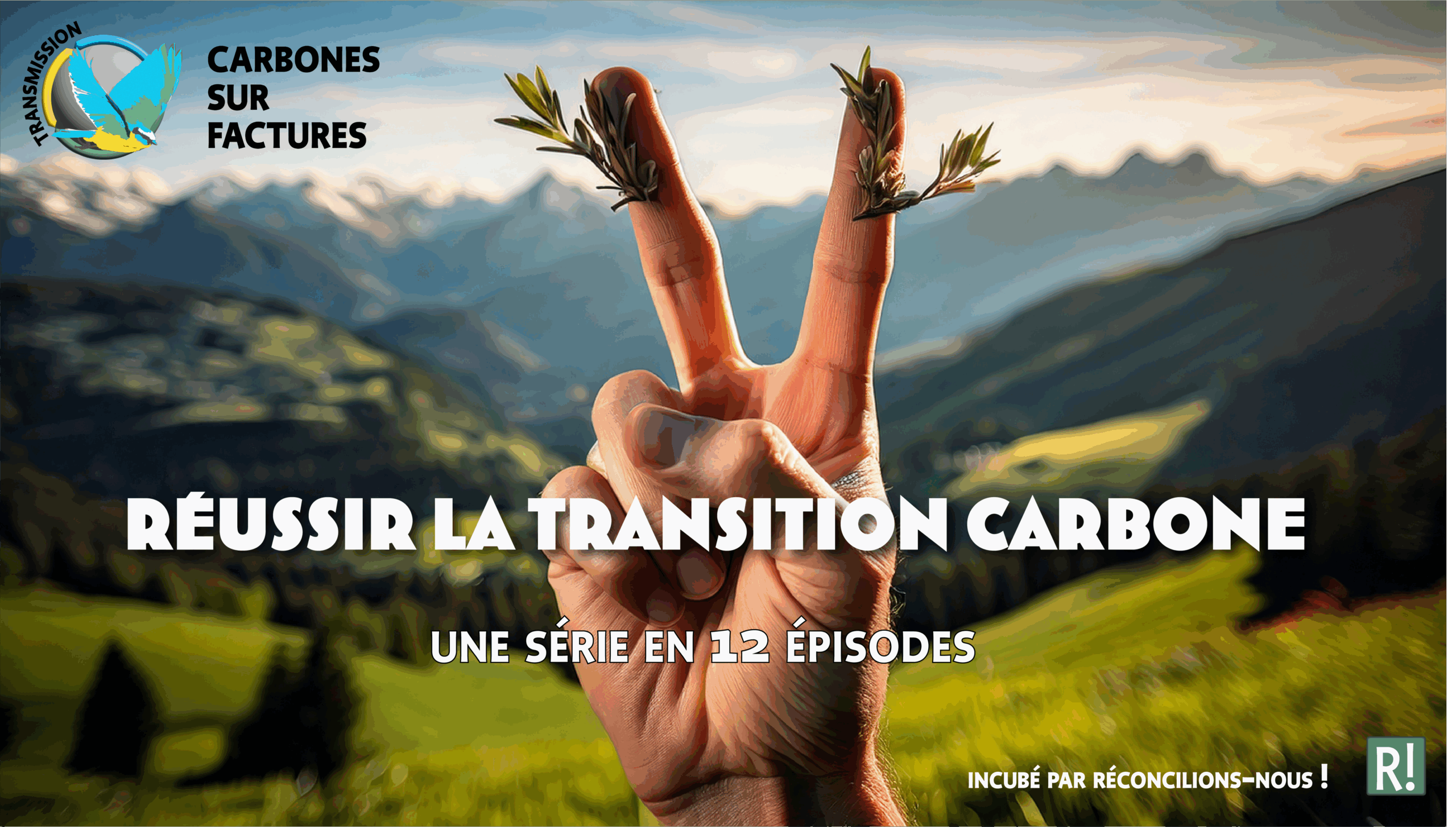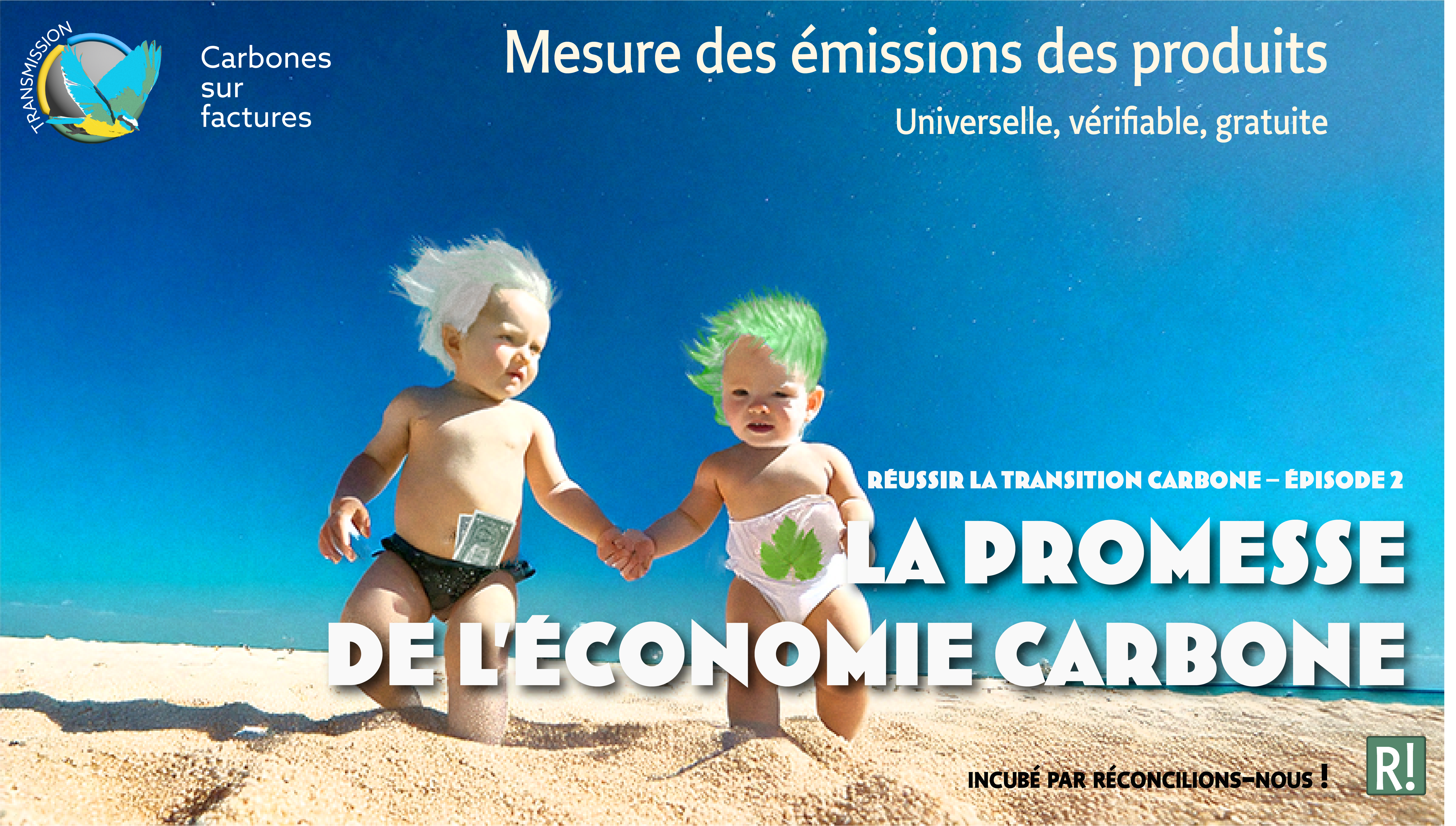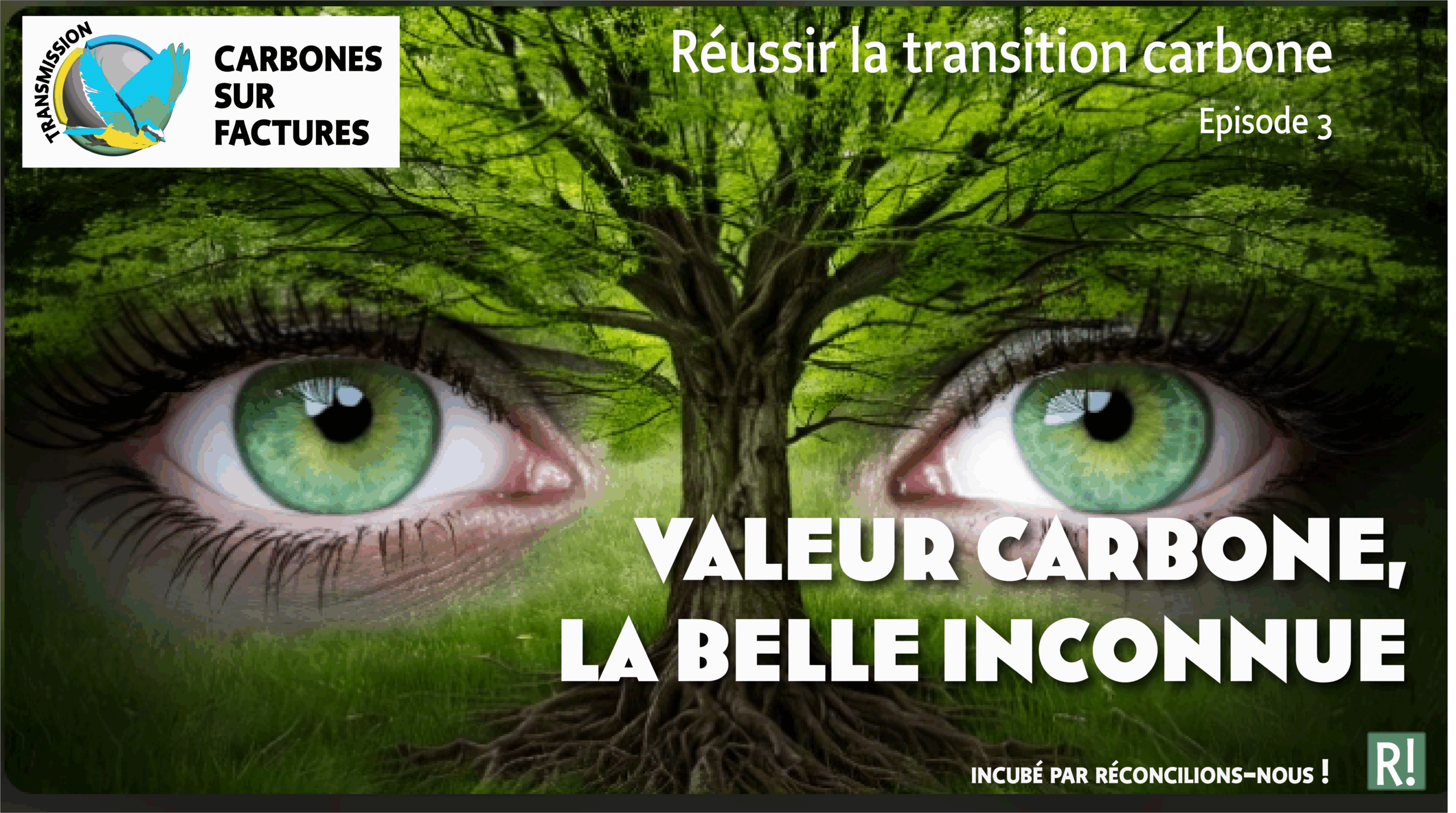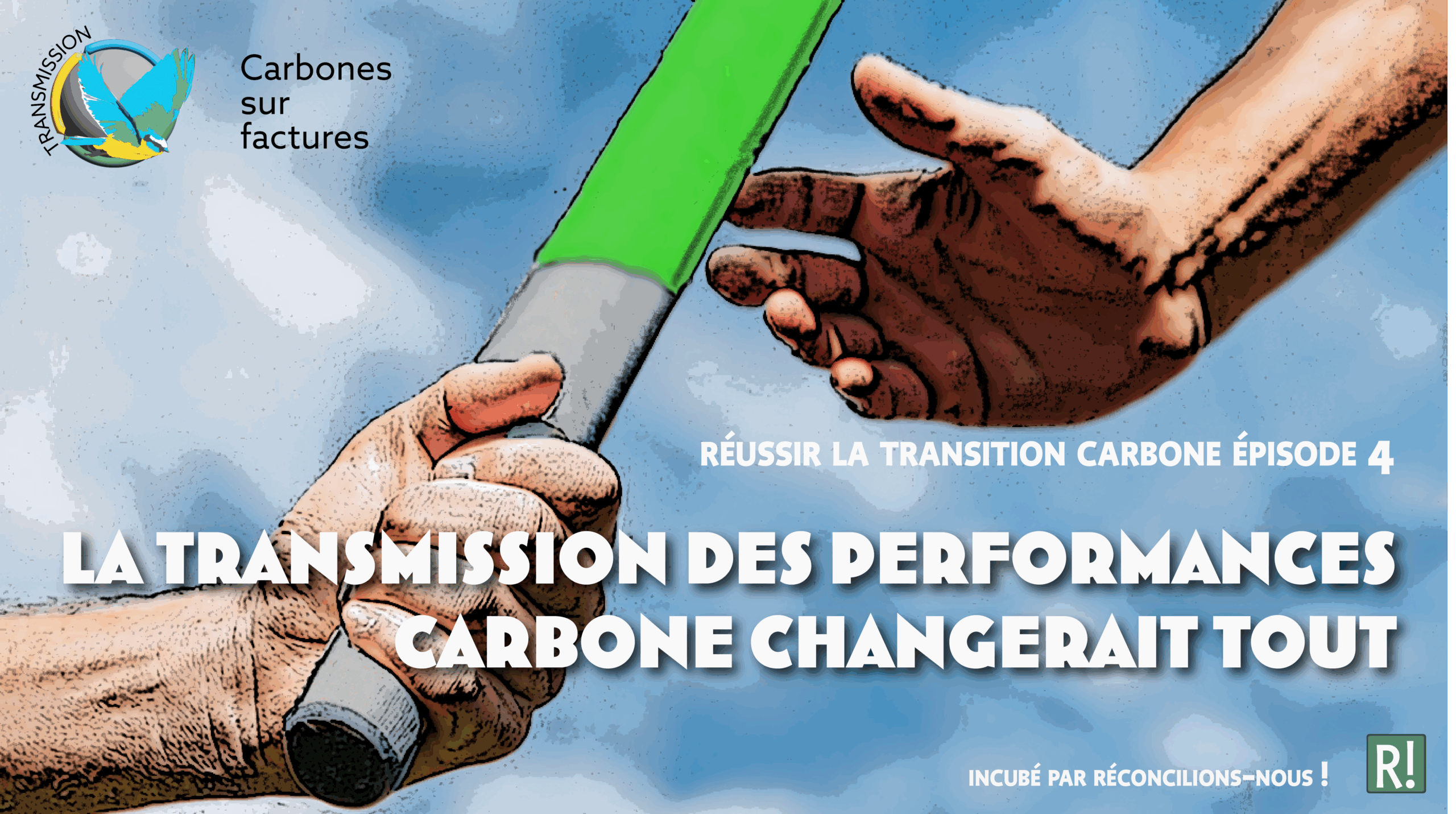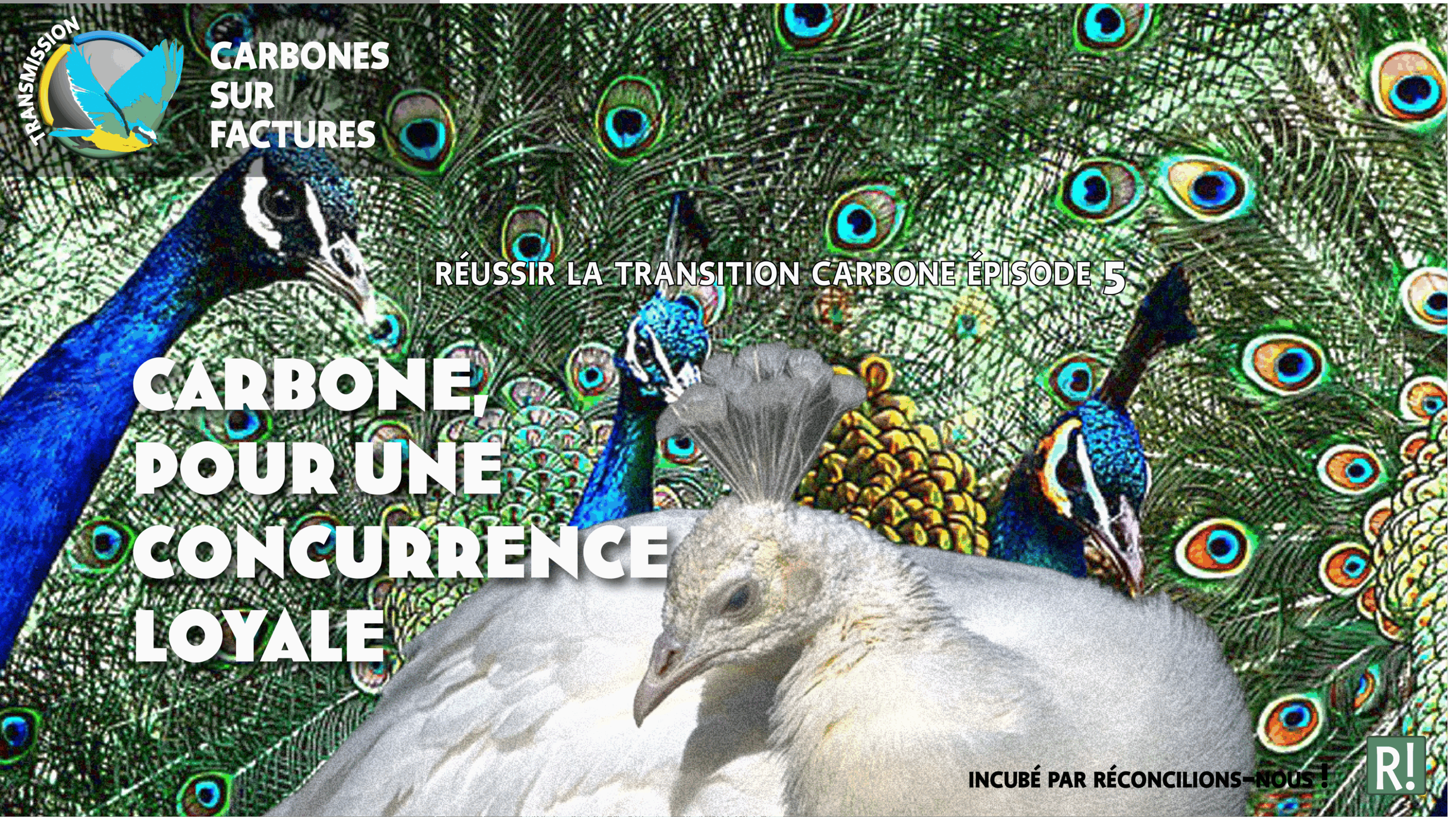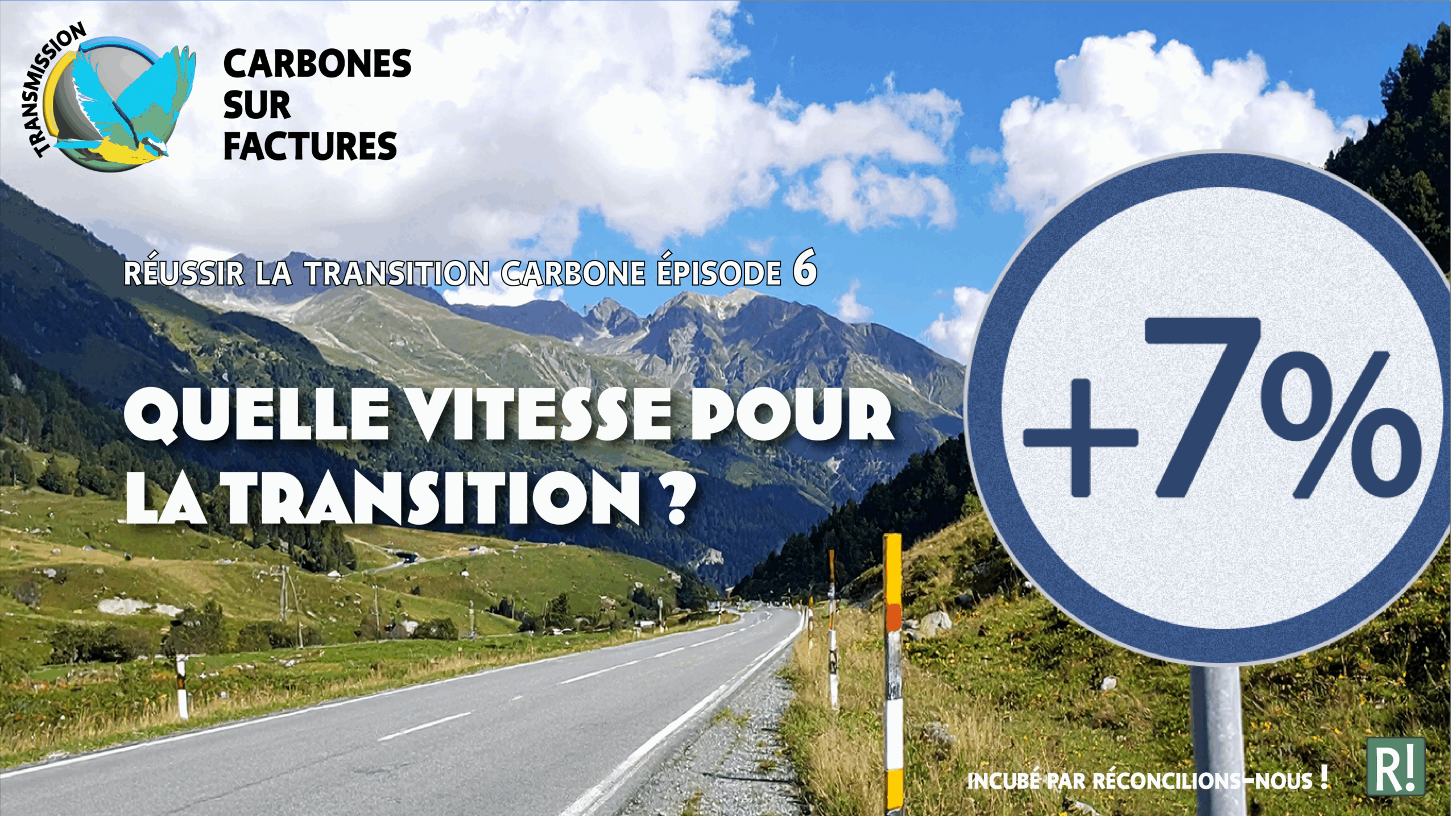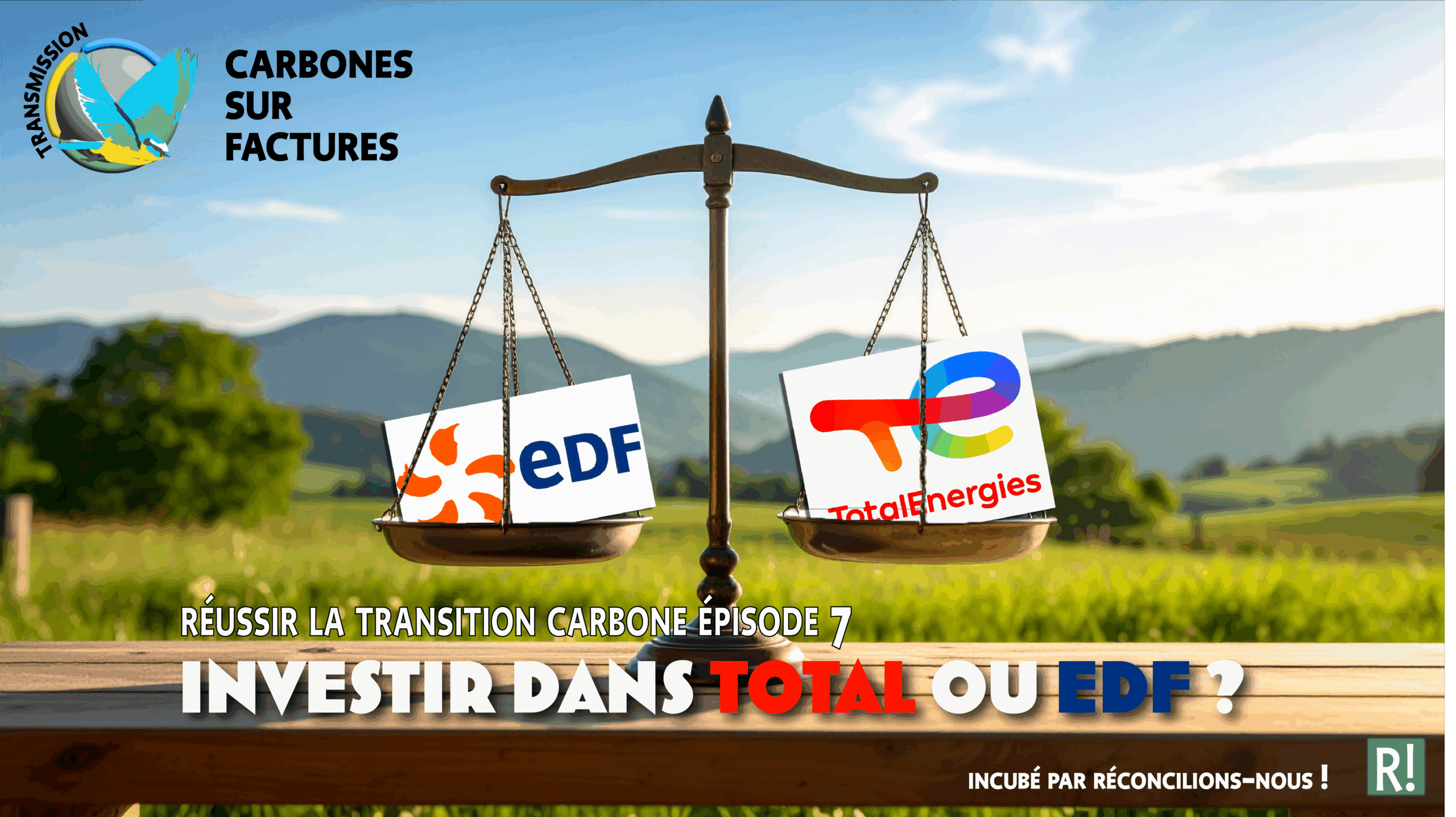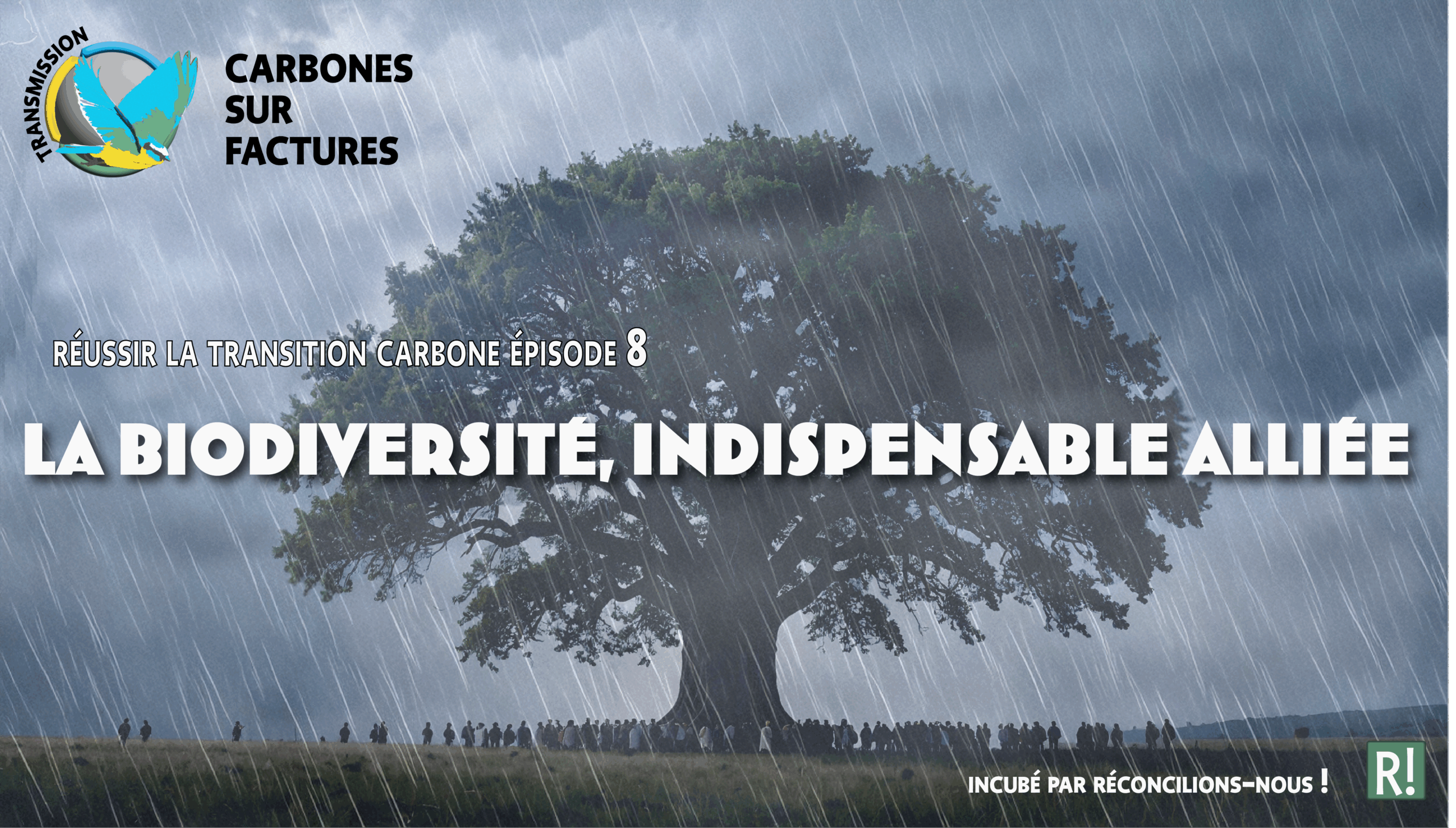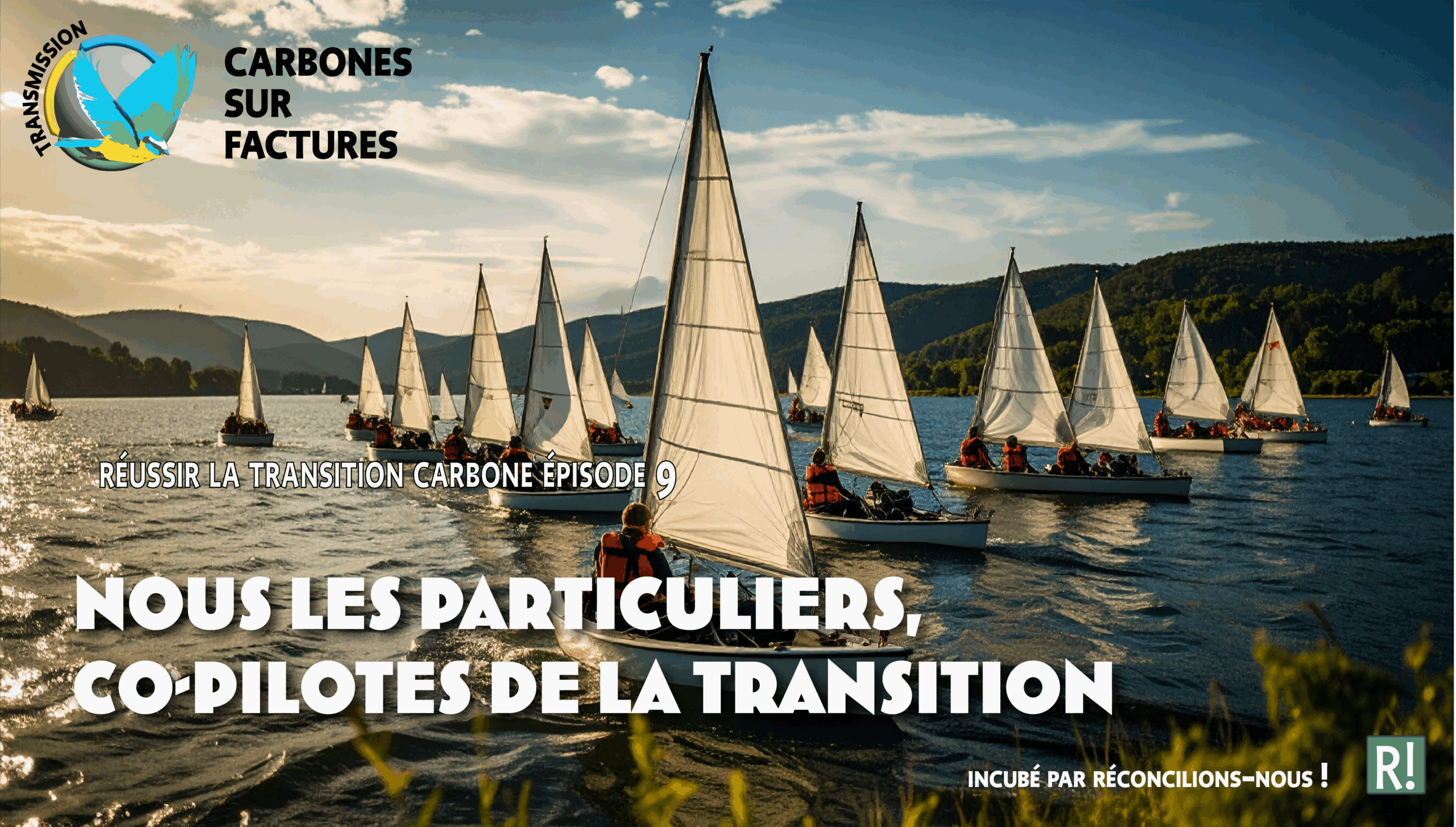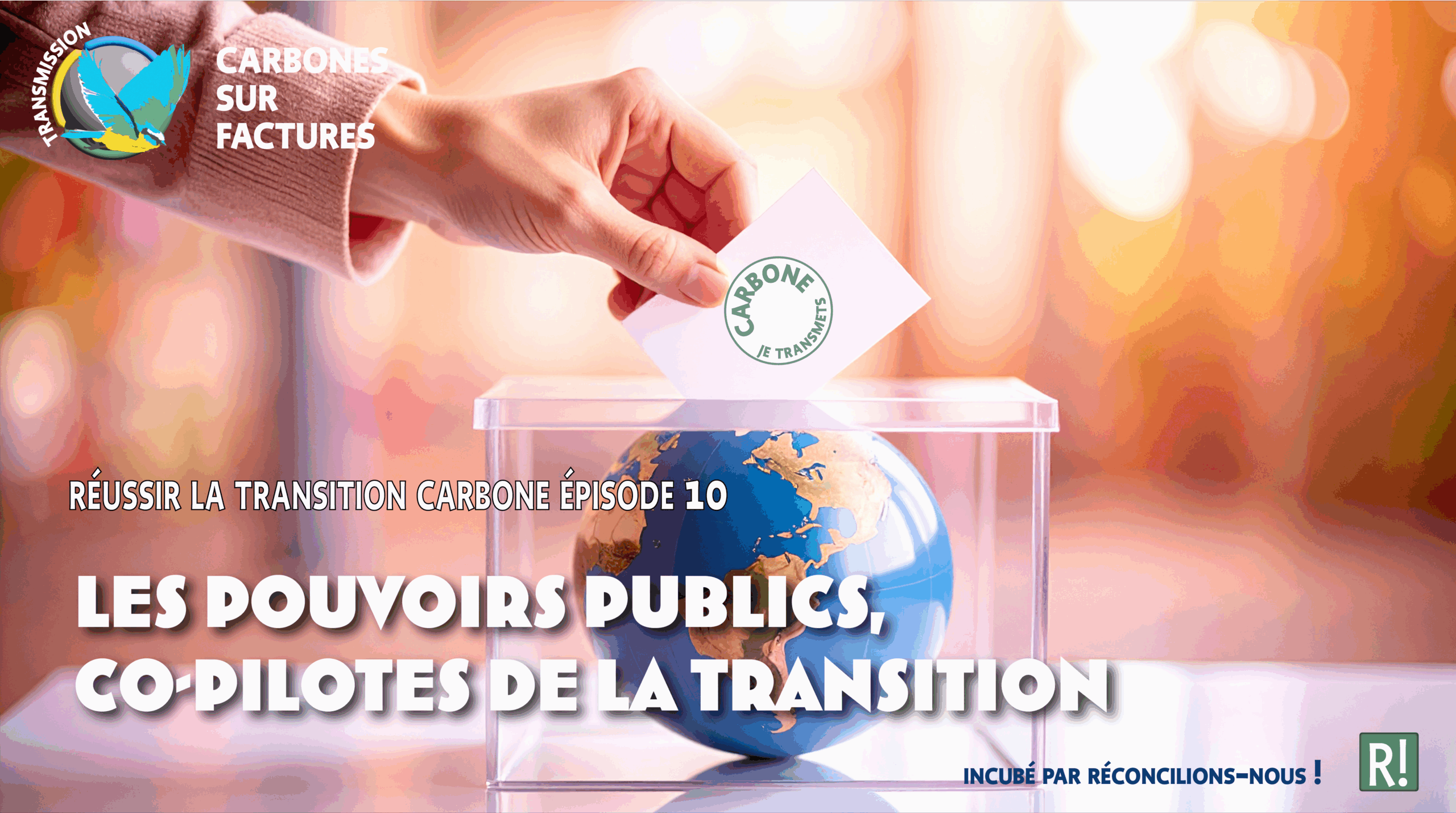Making a success of the carbon transition
A 10-episode series
The destruction caused by excess greenhouse gases (or “carbon”) in the atmosphere is accelerating. And ultimately, there is a risk that the “last generation” will be faced with desperate choices.
The carbon economy associates each economic decision, whether personal or professional, with its quantitative impact on the flow of carbon into the atmosphere, in order to balance the decision between money and carbon. And first and foremost, purchases with carbon content.
Investment decisions can also be balanced between money and carbon based on their carbon value: for a production project, an organisation, or a financial product. This is the sum of their carbon results.
Disclosing the carbon content of goods or services on invoices, and the carbon value and impact in financial information, empowers customers to make choices and promotes the carbon quality of suppliers.
Carbon content triggers fair carbon competition between goods and services, which freely drives down their carbon content.
By setting the carbon value of time to calculate the carbon value of investments, humanity is setting its minimum transition speed: the annual carbon return rate that its investments must generate, and not just ‘green’ ones.
Large producers, particularly energy producers, must calculate and report their results and carbon value to their financiers, who then pass this information on to individuals regarding their financial products.
The carbon economy integrates living organisms into the economy and the impact of human activities on living organisms. It illustrates that Homo sapiens is linked to many of the species that have accompanied it and that climate balance and biodiversity are one and the same objective.
The carbon economy gives us, as individuals, powerful levers: carbon competition, to highlight “carbon-efficient” products and investments, with a little attention as the only cost; our collective performance as consumers, to control the quantities we use ourselves.
Final episode of Successful Transition. After highlighting the priorities of producers, financiers and individuals, it sets out those of public authorities: for carbon competition with the Transmission label, incorporating biodiversity and a universal carbon measurement of time into public accounts, and drawing from the carbon economy the political compromises that will ensure a successful transition in time.
Episode 1 – Why is it important to make a successful transition away from carbon?
A phenomenon that destroys living things
Scientists have observed an excess of greenhouse gases (GHGs or “carbon”) in the atmosphere. They have found that this excess has a destructive effect on living organisms through various disruptions, particularly climate change.
They describe the extent of the destructive power of excess carbon, unrivalled by other poisons that mankind spreads by producing or consuming. Carbon is in fact in all our products and in all our projects (the closest previous phenomenon, gases destroying the ozone layer, concerned a tiny part of human activity).
Accelerating destruction
Scientists also describe the accelerating destructive power of this excess carbon. It took eight generations of carbon-based growth for the most vigilant scientists to identify the problem, and then only two generations for the whole of humanity to see it. Scientists have a good explanation for this acceleration.
Two accelerations are man-made and man can learn to control them :
– Soil artificialisation and plastics in the ocean are destroying living things and accelerating the destructive effect by reducing the natural capture of land and sea surfaces.
– Human efforts to adapt to the destructive effect (air conditioning, dykes, etc.) accelerate the destructive effect by increasing emissions.
Two other accelerations are more threatening because they are external to man : they arise from the destructive effect itself, like a fire feeding on itself.
– The failure of living species to adapt accelerates the destructive effect by reducing the natural capture of carbon in the atmosphere (weakening of trees, etc.).
– Crossing thresholds (still very poorly estimated) in the carbon surplus could accelerate the irreversible destructive effect (melting of the permafrost, changes in sea currents, etc.).
Time is against humanity
We therefore have one scientific certainty: the destructive effect will be worse for each generation compared to the previous one, until a new equilibrium is reached. Scientists’ alarm bells ringing in the face of accelerating destruction also express a common-sense concern for what might be called the “last generation”: the last to benefit from carbon before a new equilibrium is reached; or simply the last generation, because it will inherit a choice between desperate solutions. To use a more cheerful image: our human species is the hare in a race with a killer tortoise that is accelerating. The moral is no longer that of the fable: to set off “on time”; but to set off immediately “at the right speed” so as not to lose (we will return to this right speed in episode 6).
Paradoxically, the turtle’s slowness is not an advantage. How can you mobilise the entire planet for several generations in a row to deal with a slow but deadly catastrophe? Fortunately, there is a promise. Presenting it is the purpose of this series.
Episode 2 – The promise of the carbon economy
Money is not enough to manage the transition
Two monetary indicators currently guide all economic decisions : prices for the purchase of goods and services, and results (or values, the sum of results) for the financing of production projects, organisations or financial products. Unfortunately, these alone will never be enough to inform decisions about the transition :
– Two products of the same price can have very different carbon contents.
– Two financing arrangements can yield the same monetary result but with very different carbon outcomes.
We cannot tackle the collective global challenge of transition without sharing indicators of efficiency and carbon emissions : for businesses, banks and government alike, indicators shared by everyone from heads of state to individuals.
Our proposal : carbon content and carbon outcome indicators
Since abandoning monetary indicators is out of the question (unless we give up the division of labour), the transition requires that all economic choices be informed by a carbon indicator, the twin of the monetary indicator. The carbon economy easily provides these twin performance indicators by counting carbon in the same way that the economy counts money. It simply transposes the toolbox of economics, finance, management and, above all, accounting, whether national, corporate or financial, into carbon.
For purchases of goods and services, the carbon economy complements monetary performance (price) with a twin carbon performance indicator: the carbon content of the product. This is the cumulative net emissions upstream to produce what is sold (just as price is the cumulative upstream costs). This indicator is already known by various names (footprint, cumulative emissions, sum of scopes 1, 2 and 3 upstream, etc.). The carbon economy simplifies and standardises its calculation. Producers can easily communicate to customers both the price AND the carbon content of what they are buying, with their quote and then with their invoice. Details of the method and the calculators that apply it are presented in our tutorial “Optimising your products” carbon footprint’.
Episode 3 – Carbon value, the great unknown
The challenge of the transition is to build a different economy, using a minimum of carbon. It is therefore a challenge that is being shaped today by the choice of projects that are being funded.
What triggers certain projects or blocks many others is largely, and often solely, the hope of a positive financial outcome. Those who have money to invest are interested in the total return on their investment: economists refer to this total return as seen today as ‘present value’. Those who need money, such as businesses, explain to their bankers or shareholders that their project has value and is worth the investment.
The challenge of the transition is therefore to associate two values, two sets of results, in money and carbon, with each investment: investors or savers can then freely choose between different investments by balancing money and carbon.
The twin definitions of silver and carbon values
The present value of financing is therefore the total of its annual results, up to its final year, viewed from today. To bring future results back to today, the financier uses a discount rate that incorporates the “money” value of time (what rate do I ask for “extra” in a year’s time to invest).
The carbon economy transposes this definition of money to carbon: it measures the carbon results of financing (how much carbon it adds or removes from the flow into the atmosphere) and applies a “carbon” value to time. The calculation of carbon outcomes is described in detail in our tutorial ‘
Optimising your financing for carbon’ with free calculators. And we return to the carbon value of time in episode 6.
The carbon value allows all financing to be classified : +10 tonnes of carbon means that the financing should remove 10 tonnes from the flow into the atmosphere over its lifetime; and +10 tonnes means that it should add them.
The transition illuminated by carbon value
Carbon value is the invisible beauty : invisible because it is not yet visible in financial products, and beautiful because it would improve all financial decisions.
With it and the carbon result, each producer of a financial product could provide their customer with a projected performance and then an actual performance in both monetary terms AND carbon terms.
The previous episode emphasised that informed financial choices were impossible as long as it was not possible to choose the most carbon-efficient option between two investments with equivalent financial returns. The carbon economy provides this information, which is essential for a successful transition.
Episode 4 – The power of transmission
Disclosing the carbon content of a good or service on invoices, and the carbon value and impact in financial information, empowers customers to make choices and highlights the quality of offerings. It gives customers the freedom to choose and producers the freedom to act.
Individuals gain the freedom to choose
The additional information provided allows each individual to make choices based on their preferences regarding money and carbon. It opens up new opportunities for them to take concrete action on certain decisions: ‘I prioritise the carbon criterion, “it’s worth it”.’ They can take action on all their purchases as well as all their investments and give a boost to the future transition.
Focusing carbon information (product or investment) on ONE performance brings together the multiple motivations of individuals when it comes to carbon: for themselves, their families, future generations, the rest of life on Earth and biodiversity, etc. Whether weak or strong, these motivations all point in the same direction, since no one will choose poor carbon performance when given an equivalent financial return.
Producers and financiers gain freedom to act
The message from individuals will carry weight : producers and financiers anticipate what their customers expect. Reporting carbon performance stimulates efforts, and efforts justify reporting.
– ‘What’s the point of being carbon competitive if no one knows about it?’
– ‘My client will imagine the worst if I don’t tell him anything.’
Focusing on ONE performance indicator (content and carbon efficiency, respectively), which is easy to understand and calculate, makes life easier for producers and financiers. They finally have clear rules and a measurable performance indicator for their products that they can control and promote. Carbon risk becomes carbon opportunity: a universal, measurable quality whose importance in relation to money will increase as carbon destruction continues to worsen.
Transmitting carbon performance for a successful transition
The success of the transition therefore depends on good practice on the part of producers and financiers, who pass on the carbon performance of their offer to their customers :
– The carbon content of the goods or services is communicated to the purchaser with the quotation or invoice.
– The result and carbon value of the financial product is communicated to the investor (first in the information brochure, then with the dividend or interest).
How can this be made standard practice? The quickest way is for public authorities to promote transparent producers and financiers who ‘disclose’ the carbon performance of their products. This is possible at all levels and in all countries. A disclosure label is simple and cost-effective because it offers professionals advantages that are within the power of every authority: in public procurement, public funding, visibility, etc. We will come back to this (episode 10).
Episode 5 – For fair carbon competition
This episode shows how the carbon content of products (the first carbon indicator) is the basis for steering the transition.
Carbon Content has the force of a simple message: between two equivalent products, the one with the least carbon is the best for the transition.
Transmitting the Carbon Content with the products means shedding light on the billions of purchases and sales that take place every day, without imposing anything on anyone; and thus triggering a voluntary transition and a virtuous dynamic.
Individuals and the carbon content of products
The simplicity of the Carbon Content is appreciated by individuals. It brings together their different motivations in a single signal: quality of life for their loved ones, for future generations, for the living world, for biodiversity, etc. It gives them an opportunity to act according to their values – whatever they may be – in a concrete and not just symbolic way: consumers who prefer a product with less carbon, at the same price and quality, send producers a powerful economic message that moves up the production chains and triggers carbon competition.
Producers and carbon content
A simple indicator also makes life easier for producers. To manage their environmental competitiveness, they need to share their product’s carbon performance with their customers. Many complex performance indicators are required of companies that do not concern their products. As a result, 22 million European SMEs have no environmental indicators, and the indicators used by large companies do not tell their customers anything specific about the carbon content of their products. Carbon content is an easy quality to calculate (see our tutorial and free calculator : Carbon management of product performance). Working on and communicating this quality is in the manufacturer’s interest, as they know that quality, and therefore carbon content, means selling more, at a higher price and for longer.
Public authorities and carbon content
A voluntary transition can be put in place, a virtuous loop that gradually reduces the carbon content of products. Public authorities can easily and at no cost bring about this deployment.
– We have talked about creating a Transmission Label to promote producers who pass on the carbon content of their products, and to give them advantages such as markets, public funding and visibility.
– Public authorities can also simplify their environmental regulatory requirements by focusing on the carbon content of their products.
– They can reassure their citizens and producers that carbon competition is fair: by requiring imports without rigorous carbon content to be accompanied by a prudent flat-rate indicator alerting buyers, which could be reinforced by a customs tariff based on carbon performance.
Carbon Content goes beyond fair competition
The transmission of the Carbon Content and carbon competition will not be enough to ensure a rapid enough transition. But the Carbon Content has two other merits.
– Public authorities can strengthen it without incurring budgetary expenditure, by highlighting the heaviest and lightest products for the same use; or by balancing subsidies for the most carbon-efficient products with taxes on the least efficient products (such as the car bonus-malus system).
– Carbon content makes it possible to measure the carbon value of financing and, through it, to control the speed of the transition, which is the topic of our next episode.
Episode 6 – How fast should the transition be?
This episode sheds light on an obscure (and debated) question: the speed at which humanity is advancing in its transition. To simplify matters, we will pretend that Humanity with a capital H is a single person.
The speed of humanity’s carbon transition
Humanity produces what is necessary for its immediate needs (consumption) and its future needs (investments requiring financing: direct in projects and organisations, indirect in financial products). It is on financing that it relies to tackle the carbon threat: to build ‘almost’ zero-carbon production and consumption; and to protect the living world, the harvesting of which enables “almost “.
The carbon outcome of its financing is the change in carbon flows into the atmosphere. But what carbon outcome should we aim for with the financing decisions made today? The Carbon Economy suggests a scientific answer to this question.
The carbon profitability rate of global investment can be likened to the speed of the transition : if it is negative, the transition is moving backwards; if it is positive, the transition is moving forward, and all the faster the higher the projected rate. To accelerate your wealth, it’s better to invest at 50% return than at 3%. The same applies to carbon, to accelerate the transition.
What the average carbon return on global investment tells us
The low-carbon world of tomorrow is being created by investing today. The ‘global carbon profitability’ performance indicator reminds us that the success or failure of the transition depends on collective financial performance over the (very) long term.
Contrary to popular belief, tracking 10 or 20% of specific investments labelled ‘transition’ or ‘green’ will never produce a decent average result. It’s the WHOLE investment (and therefore the whole saving) that needs to be tracked. Financiers know that if they want to guarantee an average rate of return for a portfolio of investments, they need exhaustive monitoring, because the cash losses from investments that are not monitored can cost much more than the gains from monitored investments.
This is all the more true in the case of carbon: cash losses on an investment are generally capped at the amount invested (thanks to limits on the investor’s liability). The carbon loss on an investment can go well beyond the carbon invested.
The minimum transition speed
Another essential aspect of the speed of transition is that we can calculate not the ‘right’ speed (which is a political decision) but a minimum speed: the minimum carbon efficiency to be respected. This can be determined on a scientific basis, depending in particular on the maximum duration of transition that humanity (and the living organisms on which it depends) can withstand without tragedy. This minimum speed simply transposes the logic of money financiers to the carbon economy: they call the discount rate the minimum rate of profitability below which they will not finance.
Episode 7 – Financing EdF or Total Energies?
Focusing on carbon profitability in the energy sector
Humanity must generate a minimum carbon return on its average investments, not just on “green” investments (episode 6).
It is logical to start with the carbon profitability of investments by large energy producers, the No. 1 issue in the transition. A large energy producer must therefore calculate and pass on to its financiers its carbon profitability, projected and then realised, in other words (episode 3) its carbon result divided by its carbon investment. The energy producer knows his carbon investment. The Carbon Economy gives them their carbon result, based on the collective carbon result of energy producers.
The collective carbon result of energy producers
The Carbon Economy applies two principles:
– It clarifies the service provided (in this case energy) with a common unit of measurement of its quantity: the unit of the universal system where it exists, i.e. the joule for energy. National carbon accounting gives the average amount of carbon needed by producers to produce one unit: a “carbon content per joule”, which is their collective carbon competitiveness. In France, for example, it takes around 50 micrograms of carbon per joule, less for electricity (28), more for petrol (70).
– It measures producers’ collective carbon performance by the impact on the transition of year-on-year variations in “carbon content per joule”: a benefit if their average carbon competitiveness falls, a loss if it rises.
The carbon result of a particular energy producer
Each energy producer contributes to this collective carbon result. They make a profit if they reduce the carbon content per joule by the amount of the impact on the transition (and a loss if they increase it). There are two ways of achieving this:
– Improve its own carbon competitiveness. EdF will generate a carbon benefit, for example, by extending the lifespan of a power plant; and Total by reducing methane leaks and/or favouring the most carbon-competitive energies.
– Vary its sales (in joules): sell more if its carbon competitiveness is better than the average for producers, sell less if it is worse. To increase its sales AND generate a positive carbon result, Total must improve its carbon content per joule (around 64) below the average of 50 micrograms.
The carbon efficiency of each financial product
In the future, each energy producer could pass on its carbon efficiency to its financiers (or have financial analysts calculate it for them) so that it reaches the individual, helping them to balance their financial choices between money and carbon. Individuals overwhelmingly trust financial institutions to choose what they finance with their money. They will therefore be able to compare the carbon yield of a Total share and an EdF bond, but above all they will be able to compare the carbon yields of current accounts, Livret A savings accounts and life insurance products, and worry about losses.
Financial carbon competition will then emerge, gradually pushing carbon profitability upwards and carbon emissions downwards.
Episode 8 – Biodiversity, an indispensable ally
The carbon economy coordinates the transition by integrating living matter, which is vital to humanity, into the economy.
The traditional representation of live catches is misleading.
In the traditional view, humanity seeks to improve production, consumption and financing in order to reach Net Zero as quickly as possible: a new stable state where humanity’s emissions are offset by natural sequestration by other living organisms (trees, oceans, etc.). For 30 years, this sequestration has been measured “alongside” emissions from human activities, as if they were independent phenomena. Today, scientific research contradicts this representation.
The reciprocal links between human activities and natural catches
Natural carbon sequestration depends directly or indirectly on most human activities, including agriculture, forestry, fishing, chemistry, land development, etc. And this is even more true in the opposite direction: human activity requires sufficient natural carbon sequestration, since no major human activity can be carbon neutral without natural carbon sequestration, no matter how efficient producers are or how frugal consumers are.
The carbon economy welcomes living organisms into the economy
The carbon economy takes this mutual dependence into account by incorporating the natural carbon sequestration of a territory into its carbon accounting (input/output matrices): its natural carbon sequestration (in tonnes of carbon per km²) and the positive or negative impact of various human activities on this sequestration. It can also incorporate irreversible damage to the environment (ocean acidification, etc.). In this way, it makes every human decision accountable for its impact on natural sequestration. This is the only way to steer natural sequestration towards a trajectory that completes the transition.
Climate, biodiversity, desertification: a single transition
The carbon economy brings together climate, biodiversity and desertification (the three United Nations conventions: IPCC, IPBES and UNCCD). It shows that carbon accounting reasoning and the intuitions of many humans about their symbiotic relationship with nature say the same thing.
Life will survive the carbon threat: it survives well in the heart of the desert, at the bottom of the abyss, or in areas so hot and humid that humans would suffocate in the open air. But Homo sapiens is linked to many of the species that have accompanied it for 12,000 generations: failure of the transition would spell their joint extinction. The alliance is vital; success can only be shared.
Episode 9 – We, the individuals, co-pilots of the transition
The carbon economy provides individuals with powerful tools to drive the transition.
Our role? To compete on carbon, by purchasing the best carbon content and investing in the best carbon values. And to take control of the quantities we use, starting now.
Playing the carbon competition card
Playing the carbon competition game simply means paying attention to the carbon content and values of goods, services and financial products. This is enough to trigger carbon competition that rewards carbon-competitive producers and spurs their carbon innovations: so that, for example, a square metre of living space, a unit of energy, or a kilometre travelled contains less and less carbon. Competitive producers understand that they can earn more money by playing the carbon quality card. A good example is the fortune made by Elon Musk by anticipating that many Americans were willing to pay a high price for a car that was initially not very functional in order to prove to others that they were good people.
Carbon competition costs individuals only a little attention
A Tesla is expensive, so we assume that carbon competition means financial sacrifices for individuals. This is not true. Tesla buyers are treating themselves, not making a ‘sacrifice’. And we can achieve zero carbon at zero cost by choosing the most carbon-competitive product or investment for the same amount of money. (Although, of course, the transition will happen faster if individuals are willing to pay a premium in exchange for better carbon performance.)
Our first best practice as individuals is therefore to ask producers about the carbon footprint of their products and to take this into account when making our choices.
Our own control of quantities used
Carbon competition is forcing producers to continuously innovate in order to lower the carbon content of their products: reducing the carbon content per square metre of living space, per kilometre travelled or per unit of energy. They will do so gradually. However, these innovations will have no impact on the transition (and the achievement of zero carbon) if, at the same time, the quantities used per capita (and the number of inhabitants) continue to increase.
Our second best practice, as individuals, is therefore to gradually control the quantities we use: the private goods we purchase and the public services we finance through taxation.
An illuminating picture of collective progress
The carbon economy makes it possible to track annual progress on each major need: producers’ control over their carbon productivity and consumers’ control over quantities. For example, it links a major need such as mobility to the quantity used by each inhabitant, measured in terms of the number of kilometres travelled per year: worldwide, by country, etc. It also indicates the carbon value gained or lost in mobility compared to the previous year (an insufficient value if it is a loss) with the respective collective performances of producers and consumers.
These collective performances help us reflect on our personal responsibility : on our choices as consumers and our decisions as citizens regarding public services and the necessary transition rules.
Episode 10 – Public authorities, co-pilots of the transition
The carbon competition described in previous episodes will greatly assist public authorities. Each player takes charge of its own transition and, in doing so, advances THE transition. It remains for public authorities to organise this carbon competition and to bring biodiversity and finance on board. The carbon economy will also help public authorities to build fair compromises to ensure a successful transition “in time”, i.e. while the atmosphere is still viable.
We propose four messages to be relayed as widely as possible to public authorities.
Launch the carbon competition with the Transmission label
You, the public authorities, must promote carbon competition, and you can do so at all territorial levels free of charge and by consensus with the Transmission label. This voluntary, decentralised, collaborative and international scheme brings together public and private actors who respect
the first best practice of the transition: the producer passes on the carbon impact of its products to the customer
. (We will return to its launch in September, see the link above).
With national carbon accounts, you can easily report the collective annual results of the transition, by activity and distinguishing between the results of producers and consumers (previous episode). This will satisfy consumers who want to track progress in concrete terms.
Bring life and biodiversity into the economy
We also saw (episode 8) that carbon signals (by activity, by product, by financing) must integrate living organisms and biodiversity. This is a major concern for many citizens. And no human activity can function without natural capture, i.e. without living organisms and biodiversity. You, the national authorities, can easily include living organisms in public carbon statistics. And you must do so quickly, in parallel with other projects, otherwise you risk jeopardising the entire transition. Let’s take the target set by ADEME for everyone in France to reduce their annual carbon emissions from 9 tonnes to 2 tonnes: these two tonnes are supposed to be absorbed by 2050 through the capture of living organisms. The target is meaningless if we do not organise ourselves in parallel to conserve these 2 tonnes of carbon capture.
Ask scientists for a universal carbon value for time
The carbon economy can assign each investment a carbon value, i.e. the amount of carbon it will remove or add to the carbon flow into the atmosphere (episode 6). All that is needed is agreement on ONE piece of data: the universal carbon value of time, or “carbon discount rate” in economic terms, based on scientific evidence. It is up to you to encourage this research, to put monitoring of this universal rate on the agenda of future COPs, and to establish prudential monitoring of dangerous investments: those with a highly negative carbon value.
Build compromises to ensure a successful transition on time
The hardest part remains. The carbon economy provides you with the infrastructure for transition, with two equally rigorous perspectives on each decision for every stakeholder: a financial outcome for the stakeholder and a carbon outcome for the community. Everyone is then free to make better decisions (on purchasing, production, innovation, financing, etc.) that are beneficial for them AND for the community.
But often a bell will ring for the “winning” actor and the losing community, or vice versa: ‘this decision is good for you in terms of money but bad for the community in terms of carbon’; or the opposite: ‘it is costly for you in terms of money but good for the community in terms of carbon’. Carbon economics will help you measure the extent of the problem and develop effective transfers or regulations. But it will be up to you to devise the necessary fair compromises. Your task will be essential and difficult, because some of the vested interests involved are extremely powerful.
Last words
Thank you for following these episodes. They describe a way to successfully transition in which everyone plays a role. Is the presentation too fast? Welcome to our tutorials and webinars. And welcome to go further, as the carbon economy is a vast field of research!
The bad news is that the transition is likely to be much longer and more difficult than we are led to believe. The good news is that it is still possible by moving from partial control based on monetary value to general co-control based on two dimensions: money and carbon. Let’s take charge of the transition.
